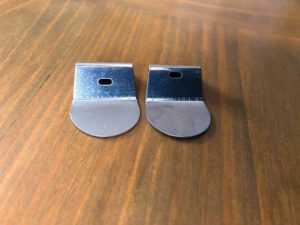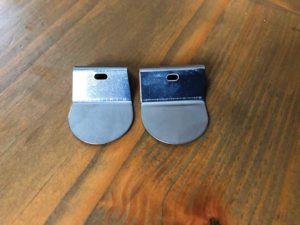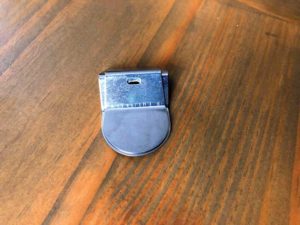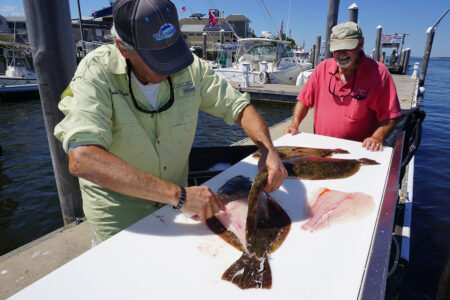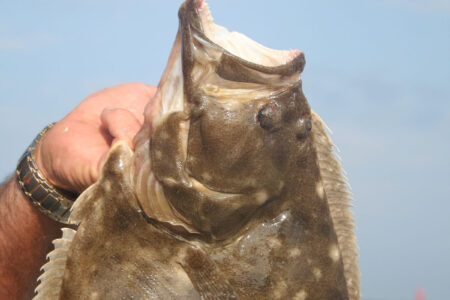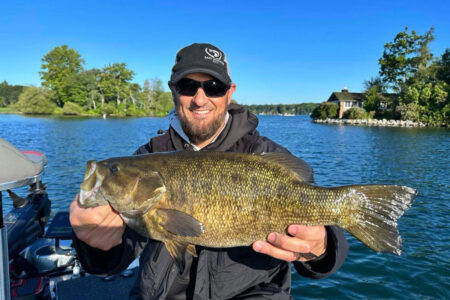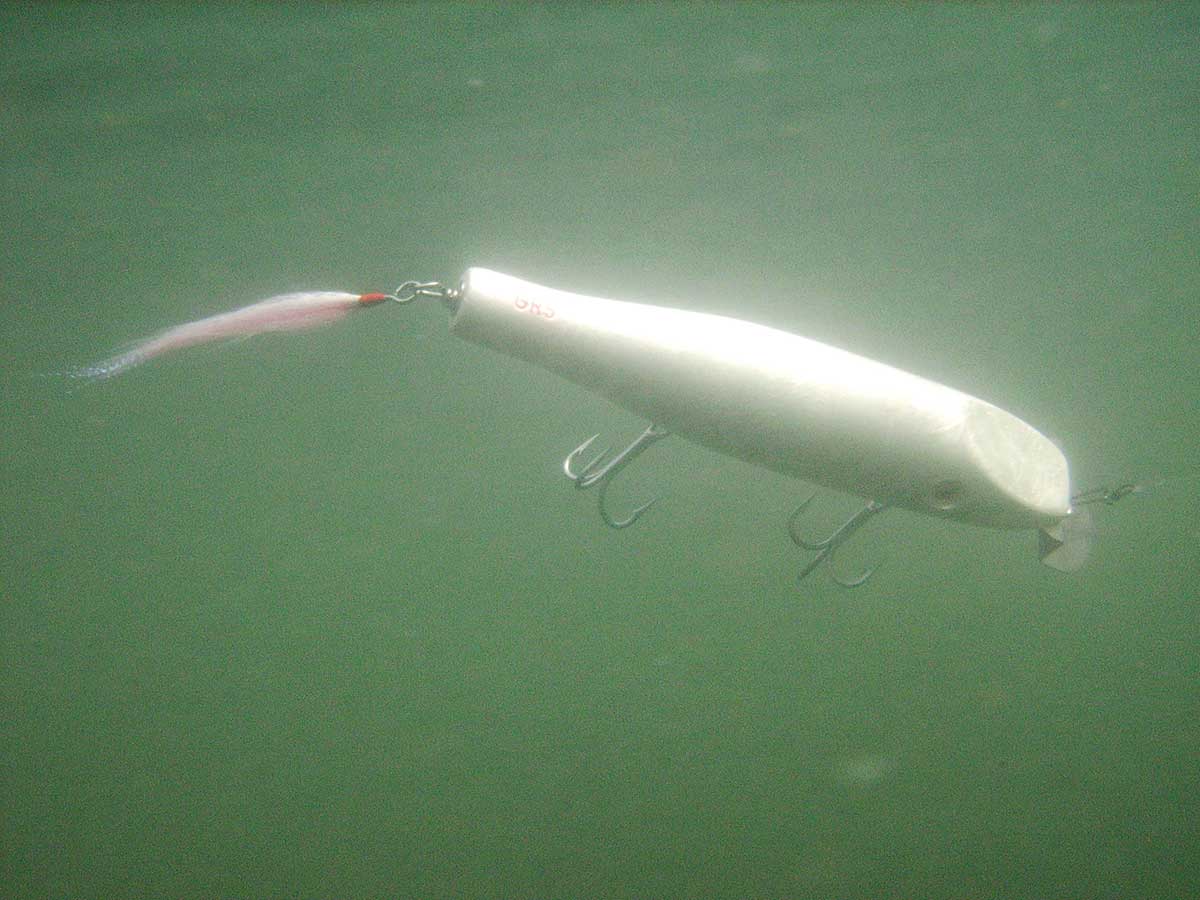
A ‘Buyers Guide’ of metal lip styles and what they do when attached to a piece of wood.
One of my favorite things about surfcasting—really striper fishing in general—is how ‘old school’ it is. We’ve benefitted from plenty of innovation over the past 30 years, but we still rely heavily on old school designs, traditional methods and plugs made by fishermen in basements. I mean, it’s pretty hard to imagine a hardcore largemouth fisherman trying to comprehend the simple colors and vaguely fishy shapes of the wooden plugs we use—realism isn’t always the answer.
Metal lips have always been a source of much chin scratching among striper anglers, and that fact has been compounded over the last 15 years as more builders have taken traditional shapes and made them do non-traditional things. Maybe the best example are BigWater Pikes; these are easily the most sought-after striper plugs being made today. I know the maker, Gary, fairly well and I know that he is just head-over-heels for pikies of all sizes, weights and colors. He has made a living of churning out works of art that can swim at many depths, and do so seductively enough to catch scores of striped bass in a wide array of situations. Gary makes his modifications using weights to alter the natural balance of the plug to encourage it to do what he wants it to do—wake or dive, and some dive just a few feet, while others get down 10 feet or more. Gary has mastered the pikie, using the same shape and the same lip to get all these different results—it’s pretty amazing. And with BigWater lures you know what you’re going to get.
But when you’re walking the aisles of a New Jersey flea market or the Saltwater Lures Collectors Club show in Westport, MA, you can’t always be so sure what you’re buying when you decide to try something from a new (to you) builder. There’s always the risk that the person building them puts more emphasis on frilly paintjobs than action, and also the possibility that this person’s Danny has been tuned to swim 5 feet deep instead of throwing a wake like a traditional version. And if you’re the type that likes to dabble with the lathe in the offseason, having a working knowledge of lip styles and what they’re capable of will go a long way when trying to work out a design for a specific spot or swimming action.
When you look at the options available to builders on the web, so much of what’s there look very similar; it might be hard to believe that a Pikie 2 lip and a Lefty 2 lip do very different things. You could say the same thing for a Danny 2 and Lefty 2, but these subtle differences in width, bend and length actually do make quite the difference.
Lip Logic
It would be easy to just drop a list of lips with blurbs about each one here and call it day, but there’s logic in all this and if you can wrap your mind around the logic then you might be able to make assumptions about plugs with lips you can’t buy anywhere like those spoonbill things from BigRock Lures.
So how does a lip work? It’s a game of give and take. The lip creates resistance when the swimmer is pulled through the water. Physics wants the lure to rotate, but the ballast of the hooks and (if present) internal weights limit the influence of the lip, meaning that the plug will roll to one side until the weight and buoyancy of the plug become a greater force than the resistance being exerted by the water on the lip, then gravity will take over, pushing the roll back in the other direction until it swings down and past the midpoint, where the lip takes over again and rolls the plug back in the other direction and so on. It’s really not that unlike a pinwheel. If you were to remove three of the four ‘wings’ on a pinwheel, it’s likely that the pinwheel would just swing back and forth in a gentle breeze and only complete rotations in a howling wind.
The location of the line tie also plays a big role in the action of the plug. The closer the line tie is to the actual center of the ‘cross-section’ of the plug, the more stable it will be in the water, meaning it won’t ‘roll out’ easily and it will also, most likely, feature a tighter wiggle. I only say ‘most likely’ because it is still possible to build in a wider swim with a weight way up front or a fat-head-skinny-tail shape. A higher line tie also tends to cause a plug to dive below the surface—unless there’s enough buoyancy in the plug to keep it up on top.
Mid-slot lips move the line tie further away from the natural center—only by 1/8-inch—but it’s enough to change things quite a bit. This slight adjustment means the swimming action is much less stable; swimmers using mid-slot lips without any added weights will often roll almost 180 degrees—think Lefty style plugs. Adding weight will allow you to temper that wobble and dial-in tighter action. As you might have guessed, a lower line tie will usually swim the plug on or near the surface and these are favored for things like Dannys, Atom 40’s and Atom Juniors. There are exceptions to this rule, though, like the Couch’s Cedar Works Jetty Swimmer, which uses a high-slot lip, an unweighted body and a narrow profile to arrive at a shallow-swimming slayer that is responsible for my largest metal lip striper to date—a fish that went 45 pounds.
Hopefully I’ve made it apparent that the line tie location has everything to do with balancing the swimming action of the plug. The line tie is the pivot point around which all of the life given to the swimmer by the lip revolves. When that point is closer to the center, the movement is closer to equal above and below the tipping point, when the line tie is lower there is a lot more mass above than there is below and this leads to exaggerated action.
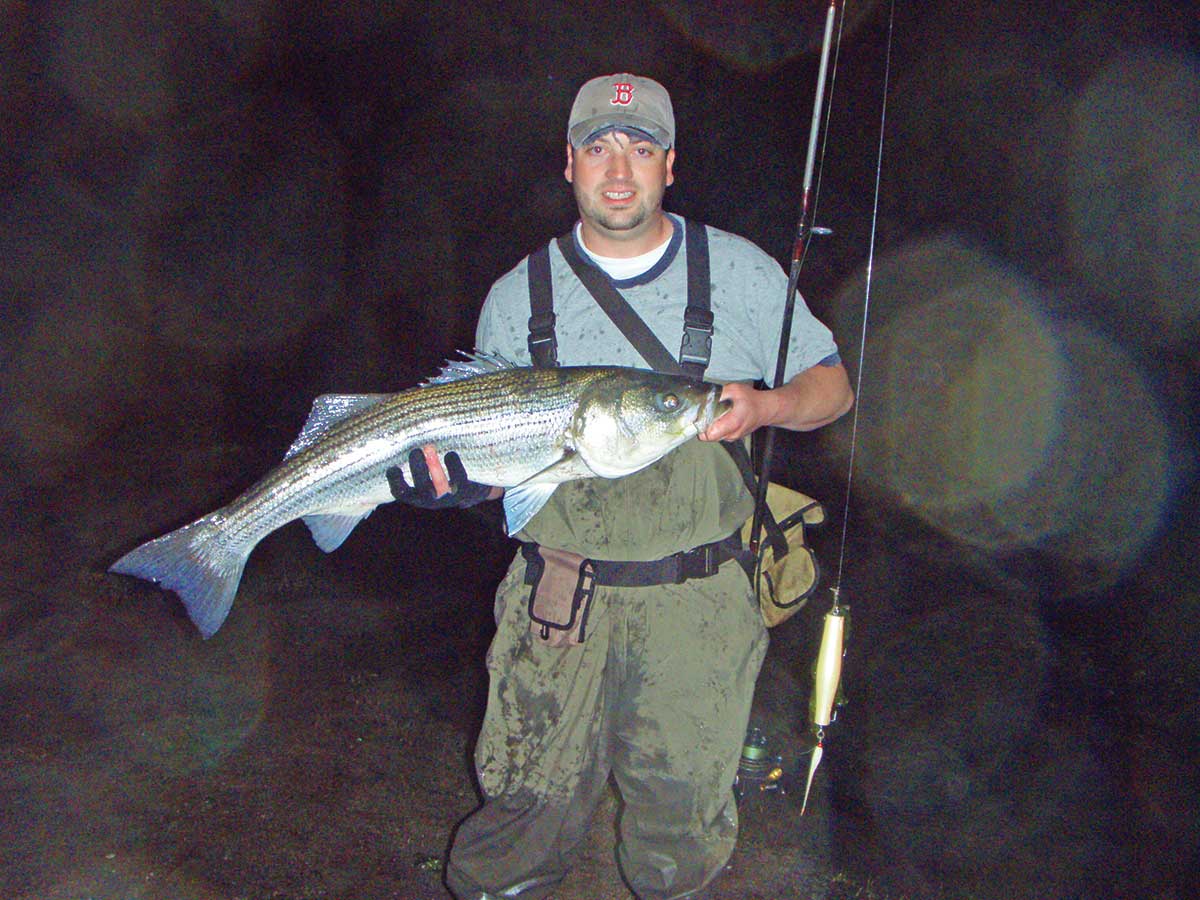
Shapeshifting
And now we arrive at shape. The shape of the lip dictates when enough water will pass to send the plug swinging back in the other direction. A wider lip means a wider swing and narrower lip means a tighter wiggle. The width of a large lip can sometimes be hard to overcome with weights alone, so sometimes a builder will curl the lower edges of the lip to allow more water to pass sooner, tightening the wiggle. Even the width of the lip where it enters the slot in the nose of the plug will affect the action, wider means more roll because it pushes more water, but a tapered lip is tighter and more stable.
The bend of the lip tells you how hard it will dig. A sharper angle digs harder while a more open angle pushes water more than it digs. Most metal lips are bent to one of two angles—the open angle of a Lefty style lip or the sharper ‘z’ shape of a typical Danny lip. Pikie lips are a mix; the smaller ones feature the sharp ‘z’ shape while the two larger versions are made with the more open bend of a Lefty. My guess is that the larger lips bent to the steeper angle dig too hard, making them very difficult to fish in anything but still, stagnant water.
Loose Lips
When you look over the list of lip styles on NJTackle.com or Saltybugger.com, you’ll see that there are three common styles—Danny, Lefty and Pikie. The Danny lips—typically—have a mid-slot and the ‘z’ shape; these are made to power a lightly-weighted body and make it swim right on top with what is often described as an ‘s-shaped’ swimming motion. The top slot versions will usually send the plug down a foot or more.
Lefty lips—in my opinion—are the most versatile. Their tapered shape makes for a very stable and tight wiggle, and because they are made in top- and mid-slot versions and two sizes, they can be used to do a lot of things. The top slot version makes excellent diving plugs. The mid works equally well for shallow divers and surface swimmers, both with a tighter wobble than a Danny lip.
Pikie lips, from the 0.5 size up to size 2 are strong diggers and put out a no-quit, rhythmic wiggle. And that can be widened by concentrating the weight in the chin of the plug, (like a Pikie is typically weighted). When you jump up to sizes 3 and 4 the angle opens up and they work more like very large top-slot Lefty lips.
Atom 40 and Conrad style lips do similar things, they can be used to power a large surface swimmer, but they are also large enough to move heavily-weighted bodies; more surface area can move more wood, so they can also be used for deep divers like Conrads and Slopeheads. The top-slot Conrad lip can be used in place of a Lefty 2 high-slot lip if a wider swim is desired.
Personally, I am not a fan of surfsters; I feel that I can achieve a more versatile surface swimmer using other metal lips. Surfster lips produce a ‘rolly and splashy’ waking wobble. Plugs weighted to near neutral buoyancy can be pulled underwater by a Surfster lip and produce a shifty—yet tight—wobble; see the BigFish Prey Swimmer.
The last lip on the list is the Goo Goo Eye lip, I have limited experience with these lips, in my experience they produce about the same results as an Atom 40 lip with a large-bodied swimmer.
Hopefully this data dump on lip styles has been informative and not too confusing. When you look at the lineup and apply some basic logic to what you’re seeing, it should start to make more sense. More surface area moves more wood and produces a wider swing. Line tie locations dictate depth and stability. The most important thing to remember is that these are guidelines, and savvy builders know how to use weight and balance to get these lips to do more than just what you expect them to. If you’re buying plugs, ask questions. If you’re building plugs, try to answer your own questions—experimentation will lead you to the best kind of knowledge there is: experience.
| SUBTLE DIFFERENCES, SUBSTANTIAL CHANGES |
|---|
| It doesn’t take a major difference from one metal lip to the next to produce a different result. Changing the line-tie location, taper of the lip or angle of the dive plane can alter the diving depth, wiggle, roll and overall appeal of the final product. However, these are not the only factors in how a plug ultimately swims as these characteristics can be accentuated or diminished by the use of different types of wood, placement of weight and shape of the plug.
In Photo 1, the Lefty 2 mid-slot (left) will generally produce a more stable plug that swims closer to the surface than a high-slot (right) lip would produce with all other factors being equal. Photo 2 shows a Lefty 2 high-slot (left) and a Danny 3 (right) which are not all that different as they feature the same bend, widest point and overall length, but that taper down at the top makes the Lefty more stable and gives a tighter wobble. You can see this taper when the Lefty 2 is placed on top of a Danny 3 as in Photo 3.
|

